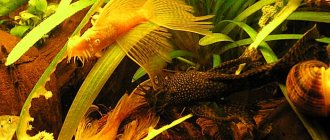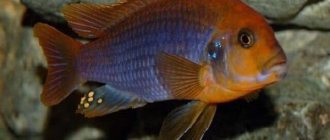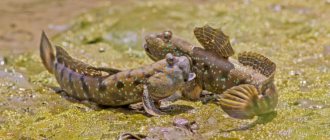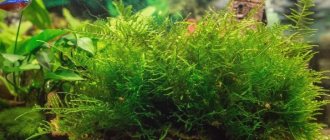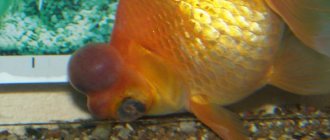Despite its large size, the fish is popular among aquarists due to its unusual behavior and colorful body pattern, reminiscent of the skin of a giraffe, which is why it is sometimes called the Giraffe Cichlid.
Requirements and conditions:
- Aquarium volume - from 470 l.
- Temperature - 23–28°C
- pH value - 7.0-8.0
- Water hardness - medium and high hardness (10–25 dH)
- Substrate type - sand or fine gravel with piles of stones
- Lighting - moderate
- Brackish water - acceptable at 1.0002 concentration
- Water movement - moderate/strong
- Size - up to 25 cm.
- Nutrition - high protein food with a small amount of herbal supplements
- Life expectancy is up to 10 years.
Natural habitat
In the wild, the Malawi cichlid inhabits only one place on the globe - Lake Malawi, located in Africa, hence the name of the species. The fish lives exclusively in the coastal zone of the lake, swimming at a distance of no more than 12 meters. The golden leopard feels equally comfortable in rocky and sandy lake areas. The Malawi cichlid is an absolute predator.
In its natural habitat, the golden leopard is interesting to watch during the hunt. The fish hides at the bottom of the lake or in rocky ledges and pretends to be dead. As soon as prey swims near it, the leopard immediately attacks it, and with such a sudden movement that the victim does not have a single chance of salvation. This style of hunting is called ambush.
Under natural conditions, cichlids live in small flocks (no more than 4 individuals). The flock is always dominated by the male, who zealously protects his area of the lake and the females from the encroachments of other cichlids and lake neighbors.
How to determine gender?
You will only be able to find out who in your flock of astronotuses is a boy or a girl by the age of 1 year.
Astronotuses are monogamous, so it is advisable that all fish were purchased at the same time and of the same age .
During the year that they grow up, pairs will be identified, and then you will be able to identify a male and a female based on some characteristics. The established couple is inseparable throughout their lives.
How to visually discern sexual characteristics:
- If the fish are the same age, then the size indicates the male - he is larger than the female. In addition, he has a more massive forehead.
- There are also differences in the fins: in the female they are small and rounded, in the male they are long and pointed.
- The male, ready for spawning, releases a cone-shaped vas deferens, the female acquires a trapezoidal ovipositor.
Appearance
The golden leopard in its natural habitat reaches a length of about 25 cm. Aquarium specimens grow no more than 15 cm, but the intensity of their growth depends on the size of the aquarium. If the volume of the tank is large, this will contribute to more active growth of the fish.
The shape of the body resembles an egg or an ellipse; it is tall, slightly flattened on the sides. The head is quite large and massive, in relation to the body it is 1/3. The eyes of the fish are large, expressive, located on both sides of the head.
The shape of the eyes is round and clearly defined. The fish are characterized by massive, large and very thick lips . The shape of the fins is even, the tip of the tail is V-shaped. However, there are individuals in which the end of the caudal fin is even.
The golden leopard is endowed by nature with a very unusual coloring, thanks to which it stands out against the background of its aquarium neighbors and is immediately memorable. The main color is striped with alternating stripes of yellow with a beige tint. The main tone has spots of green with an olive tint. These spots are arranged in three rows.
A distinctive feature of the color is the presence of several dark stripes that start from the eyes and end at the lips. When the fish grows, the spots on the head increase and stretch from the eyes throughout the body to the caudal fin. The color of the anal fin is yellow, the fin on the abdomen and chest is colored blue.
It is possible to distinguish a male from a female only after the individual reaches sexual maturity. In males, the color changes slightly during this period and becomes several tones darker than in females. The spots on the body of males fade or disappear completely. Blue blotches appear on the top of the head, and a golden stripe appears in the middle of the forehead. The fin on the back acquires a bright edging line along the edges.
A bright fish, isn't it?
Naturalists compiled a description of this Malawian cichlid at the very beginning of the last century, giving it the scientific name Nimbochromis venustus. There are also synonyms: Cyrtocara venustus, Haplochromis venustus. In a number of sources you can find the Russian transcription of the name - “venustus” or “tsirtokara”, and in pet stores the fish is most often called the golden leopard.
In accordance with the generally accepted scientific classification, “leopard” belongs to the family of cichlids of the perciformes suborder of the perciformes order.
Features of keeping in an aquarium
The Malawi cichlid is recommended for experienced aquarists to keep. It cannot be said that the golden leopard requires the creation of complex and specific conditions for a comfortable life in a water tank, but some requirements will have to be met.
Given their fairly large size, golden leopards need to be kept in an aquarium with a volume of at least 200 liters.
You can do more, then the fish will be generally comfortable and they will grow bigger. According to experts, the optimal aquarium is a species aquarium, since in the presence of neighbors, aggressive character traits can appear, which is especially pronounced during spawning.
Malawi cichlids in an aquarium prefer to live at the bottom or in the middle layer of water; they very rarely swim to the surface of the aquarium. An artificial tank must have various decorations - grottoes, castles, peculiar caves that serve as a cozy shelter for the fish. The more such shelters you build, the more comfortable it is for the golden leopard. At the same time, the likelihood that adults within the flock will fight for territory will significantly decrease.
The optimal soil is bottom soil; if there is gravel at the bottom, it must be rolled. Golden leopards love to constantly dig up the bottom, so various plants that must grow in the aquarium must be fixed or planted in pots. Vallisneria, limnophila and other plants with strong and tenacious roots are suitable as plant crops.
It is equally important to maintain water indicators at the proper level:
- temperature regime – +25° – +27°C;
- pH level – from 7.5 to 8.5;
- degree of hardness – 8-20.
In addition, it is recommended to equip the aquarium with powerful filters to combat processes such as aqueous nitrification. Filtration should be biochemical; every week it is necessary to siphon the bottom (read more about how to properly siphon soil in an aquarium) in order to remove remnants of food and other organic matter from the soil.
The water is changed once a week - about 30% of the total amount of liquid in the container. The golden leopard has no special preferences in lighting, so the standard is set to 0.5 W/l. If all maintenance recommendations are followed, the life cycle of a golden leopard will average from 7 to 9 years.
Compatibility
When selecting cichlids to live with, it is important to consider their size, region of origin, and general aggressiveness/territoriality. Also, much will depend on the volume of the aquarium and its internal arrangement.
Compatibility with other cichlid species
Cichlids are best kept with larger-sized cichlids in spacious aquariums with plenty of hiding places and a predominance of females.
This will reduce intra- and interspecific struggle, as well as reduce the likelihood of males fighting for the attention of females. It is not recommended to keep adults and juveniles together - in most cases, juveniles will endure constant beatings from their older comrades and are in constant stress
Aquarists have long found out that different species of cichlids of the same age, reared together, are more tolerant of each other than those that are introduced later.
Malawian cichlids in a community aquarium
You should not plant cichlids from different geographical regions in the same aquarium, that is, the proximity of South American and African cichlids will be uncomfortable for the fish. Firstly, their optimal water parameters are significantly different, and secondly, American species are often much larger and more aggressive than their African relatives, which can lead to constant fights and oppression of the latter. Cichlids from Lake Malawi and Tanganyika are more compatible, the main thing is to choose the right size of the aquarium, make zoning and provide a large number of shelters.
Compatibility with species of other families
Many are sure that it is simply impossible to keep cichlids with fish from other families. But in this case, we do not take into account the fact that cichlids are a very heterogeneous group of fish, and not all of them are active predators, killing everything in their path. The so-called “dwarf” cichlids - apistogramma, pelvicachromis, etc. can easily get along in the same aquarium with almost any small species of medium activity (neons, minors, tetras, etc.) and even shrimp. The second excellent example is the popular angelfish, which also belongs to the cichlid family. Moreover, in most cases, the fish show absolutely no aggression towards neighboring species and can easily live with swordtails, mollies, thorns, etc. At most, they can drive away eggs from laying eggs. It is also worth noting discus fish - absolutely peace-loving cichlids, whose compatibility with other species is limited only by non-standard conditions of detention.
African cichlids and pterygoplichts
Some relatively large species can also be calm. For example, the lemon labidochromis, or yellow cichlid, grows up to 10-12 cm in an aquarium, but has a very gentle disposition and at a young age gets along quite well even with peaceful fish species. The peaceful nature is often observed in black-striped cichlazoma.
It is better to select neighbors for cichlids that will not fit into the mouth of an adult. Cichlids usually lose interest in fish that are not considered food. Ideally, the mates should be the same size or slightly larger than the adult cichlids in the aquarium. A good example is the shark barb, which, due to its size and high mobility, is a frequent guest in cichlid fish tanks with medium and large fish.
Editorial: Aquarium cherry
Of course, you should not put large species and small species, for example, astronotus and neons, in the same aquarium - neons will quickly become live food for large American predators.
Cichlid Personality Traits
Golden leopards are rather nervous and aggressive fish. Males of this species are especially intolerant if they find themselves in rather cramped living conditions in a small aquarium. Males will constantly engage in battles.
Considering this feature of the behavior of golden leopards, they must be kept either in the form of a harem, when the flock consists of one male and several females, or a water tank must have a volume of at least 500 liters so that 2 males of this species live in it, and they do not overlap together.
Due to the fairly pronounced aggressiveness of golden leopards, it is not recommended to keep them with other underwater inhabitants, because for males, females are absolute property, and the territory of the aquarium belongs only to them. Golden leopards are especially aggressive during spawning.
Nutrition
Golden leopards are predatory fish that prefer in their diet:
- small fish;
- larvae;
- snails;
- worms;
- tubifex;
- daphnia;
- bloodworm;
- Artemia.
From time to time it is recommended to give the fish beef heart or meat. In addition, they will enjoy eating pieces of crab sticks with pleasure. Cichlids are quite aggressive fish, but if you introduce specialized food in the form of granules into your diet, their character will improve, becoming calmer and friendlier.
Feeding cichlids
The wide variety of conditions in which cichlids live has led to the fact that all types of food can be found in this group of fish. There are carnivorous, herbivorous and omnivorous species. Therefore, when choosing food, it is necessary to take into account the natural origin of fish and know their natural diet.
Cichlids can be called predatory and feed on small fish, zooplankton, mollusks and crustaceans. This group includes some African cichlids, cichlids, and American cichlids. Food for such fish must be rich in protein, otherwise growth and development may be delayed.
Malawian cichlids of the Mbuna group are typical vegetarians. Their diet should consist of 60-70% plant foods. In nature, these fish have adapted to scraping algae from the surface of rocks. In this they are helped by sharp teeth, which can also serve as a formidable weapon in skirmishes over feeding territory.
Despite the predominance of one type of food, not a single herbivorous fish will refuse to eat meat. This is necessary to compensate for the lack of essential amino acids in the body. Predators also need periodic feeding with plant foods as a source of vitamins.
Very often, owners start feeding cichlids, especially large predators, from the table: fish scraps, ground beef and even cat food. Unfortunately, this often leads to disastrous results. Firstly, the quality of the water in the aquarium may deteriorate. Secondly, fish do not always have the necessary enzymes to digest and assimilate proteins from an atypical diet (in nature, cichlids do not eat cows). Thirdly, a large amount of protein for herbivorous species will sooner or later lead to disruption of the gastrointestinal tract in fish. Finally, it is extremely difficult to balance such food with all nutrients and vitamins.
Thus, when feeding cichlids, it is best to pay attention to high-quality dry food, which is created taking into account the nutritional characteristics of the fish and is completely balanced. Tetra offers a wide range of food for different types of cichlids:
From the editor: Aquarium plants care and maintenance secrets
- Tetra Malawi (flakes and granules) is a high quality food with a special algae mixture ideal for feeding all herbivorous cichlids. Ideal for Malawian cichlids of the “Mbuna” group: golden melanochromis, pseudotropheus Sokolov (Pindani), haplochromis cornflower, aulonocar Nyasa, etc.
- For dwarf cichlids such as Apistogramma or Pelvicachromis, small granules such as Tetra Cichlid Mini Granules are a good choice. They fit perfectly into the small mouth of the fish.
- Tetra Cichlid Color is a floating food in the form of balls with a concentrate of natural color enhancers. Provides vibrant color to all types of red, yellow and orange cichlids. It will be indispensable for keeping hummingbird cichlids, aulonocaras, and golden leopards.
- Tetra Cichlid Sticks are the basic stick food for all cichlid species. Floating granules stay on the surface of the water for a long time and quickly saturate large fish such as astronotus or acara.
- Tetra Cichlid XL Flakes are the main food in the form of large flakes for all types of cichlids. The flakes remain floating on the surface for a long time and are good for fish that bite off pieces of food slowly, such as angelfish.
- Tetra Cichlid Pro is an innovative food in the form of chips, manufactured using gentle low-temperature technology, which allows you to preserve even more nutrients and vitamins. It will be a good help when feeding active medium-sized cichlids: princesses of Burundi, black-striped cichlids.
It is recommended to feed the fish several times a day with such a portion of food that they have time to eat in a few minutes. Do not overfeed the fish. It is useful for large cichlids to have “fasting days” once a week. The more varied the feeding of the fish, the better their health will be.
The best aquarium neighbors
In order for golden leopards to feel calm, it is recommended to keep them in small flocks only in a species aquarium, but if you still want to place them in a common tank, you need to take the selection of neighbors very seriously.
Golden leopards will coexist quite calmly with cichlids that are approximately equal in size to them, for example, Haplochromis Livingston. But even if these fish are kept with other neighbors, the artificial tank must have large enough volumes so that the fish do not overlap and do not fight for free territory.
When starting a flock of golden leopards, you need to take into account the basic rule - all the fish must be young, about the same age. Adults will not accept a newcomer into their group and constant clashes will occur.
Compatibility
The fact that the best method of keeping is species-based is associated not only with the natural aggressiveness of golden leopards, but also with issues of maintaining the purity of the breed.
At the same time, there is positive experience of being kept together with other Malawian cichlids of approximately the same size: Haplochromis Livingston, Aulonocara and Haplochromis, for example. The main thing in this case is that the aquarium is spacious.
There is also a widespread belief among cich catchers that representatives of the trophy groups Utaka and Mbuna should not be kept together. This opinion has a completely logical justification - while the former are predominantly predators, the latter prefer plant foods. Mbuns suffer from this content, since too much protein in the diet can cause diseases of the gastrointestinal tract.
It is better to start Venustus fish immediately in a harem flock, because in adulthood the fish will receive a hostile reception of a new member of their established group. Or rather, they won’t accept it at all.
Spawning time
The period of sexual maturity occurs in cichlids when they reach the age of 11-12 months. Spawning can occur both in a general aquarium, and when two adult individuals are moved into a separate tank - a spawning tank. To stimulate the process of fish reproduction, it is enough to increase the water temperature by a few degrees.
In preparation for breeding, the male golden leopard makes a hole in the ground with his nose, which is later used by the female for laying eggs. When the eggs are laid, the male immediately fertilizes them. During spawning, the female lays about 50-130 eggs, such a small number is considered unusual for fish.
The eggs are borne by the female in her mouth.
The duration of the incubation period is from 15 to 20 days, depending on how carefully all the conditions for a comfortable life for the fish were observed.
As soon as the fry emerge, they swim out of the female's mouth, but until they become independent, they can use the mother's oral cavity for protection and shelter from potential danger.
Adults do not pose a threat to young animals, since they do not eat eggs or fry. But still, given the rather aggressive behavior of golden leopards, in order to maximize the protection of the offspring, it is recommended to place the fry and the female in a separate tank and keep it there until the fish grow a little.
Golden leopards have a fairly well developed parental instinct. The female accompanies the fry everywhere, never leaving them for a minute. But the period of tireless parental care lasts only 10 days, after which the fry become large enough to independently obtain food for themselves and protect themselves from enemies.
Feeding the fry
As soon as the fry grow a little and begin to swim on their own, they need to start feeding. The first complementary foods for the younger generation are brine shrimp and cyclops. The growth of the fry is quite intensive, so after a few weeks they can be switched to adult food, which is first crushed, and then becomes larger as they grow older.
Reproduction
Its mechanism is in many ways similar to the reproduction of many other African cichlids. At the age of 11-12 months, the fish become sexually mature and capable of reproduction, which is possible both in a general aquarium and in a specially equipped spawning tank.
Mating behavior and subsequent spawning are stimulated by increasing the temperature of the aquarium water by about 2 degrees.
First, the male digs a hole in the ground, then the female lays her eggs in it, which the male fertilizes. In just one spawning, from 50 to 130 eggs can appear.
The female carries the eggs in her mouth, and this process continues for 15-20 days. The emerging fry, having left the mother’s mouth, can hide in it in case of danger, since female golden leopards do not devour their offspring.
It is desirable that peace and tranquility reign in the aquarium with the female bearing eggs, since the fish cannot eat during this entire period and is completely defenseless against aggressive relatives. It is also not worth transplanting it into another container, since from fright and stress it can swallow the offspring.
If more than 3 weeks have passed since spawning, and the female does not release the fry, then you will have to help her, since the babies may simply die of hunger. You can tell whether the fish need help by the behavior of the juveniles and the female - when the female takes a breath, tiny fry may try to swim out of her mouth, but the adult fish immediately pulls them back in.
In this case, you will need to catch it, place it in a bowl of water and, holding the body of the fish with one hand, open its mouth with the other using a toothpick. At the same time, the female needs to be gently shaken from side to side so that the fry can swim out. Sometimes, using a thin tube, they direct a stream of water directly into its mouth, helping to wash out the young.
Starter food for juveniles are nauptilus, cyclops, and brine shrimp. The fry grow quite quickly, so after 2-3 weeks of independent life they are recommended to be gradually transferred to specialized commercial feed.
The golden leopard is a very interesting and cute fish, which, undoubtedly, is a decoration for any cichlid fish.
Venustus spawning:
Leopard diseases
Golden leopards are fish that are quite strong and physically resilient. If you create the right living conditions and maintain constant water parameters in the aquarium, these cichlids will live for many years in good health.
Cichlids have virtually no predisposition to any diseases. But at the same time, fish are sensitive to nutrition, which should be varied and balanced. In addition, cichlids react extremely negatively to changes in the chemical parameters of water.
If all the necessary conditions for a comfortable existence are not met, golden leopards are highly likely to develop a disease such as Malawi bloat. It is quite difficult to cure this disease, so you need to carefully monitor the maintenance of the aquarium biocenosis at the proper level.
Nutrition
Since we are talking about predatory fish, it is clear that the best option for them would be live food: earthworms, snails, small shrimp and fish, insect larvae. It is also possible to use frozen food - brine shrimp, cyclops. You can give your pets pieces of fish. Frozen food must be thawed first. They need to be thrown into the water in small pieces.
It is also acceptable to use artificial dry food - granules or flakes. However, in no case should you completely switch to them if you want to see your pets active and healthy.
Feeding is carried out four to five times a week. Uneaten food residues should be immediately removed from the bottom of the aquarium to avoid rotting and accumulation of ammonia in the water, to which cichlids are very sensitive.
Is it worth buying a golden leopard?
It is believed that only experienced aquarists can keep a golden leopard, since caring for it requires certain skills and abilities. But if a novice aquarist or an ordinary hobbyist has an idea of how to correctly set the degree of water hardness, pH level and keep these indicators at the same level, no difficulties will arise in keeping and caring for the golden leopard.
Another equally important condition for creating a comfortable life for a cichlid in an aquarium is a varied diet of animal feed.
From time to time, the fish can be given green vegetables - cucumbers and zucchini.
This is necessary so that leopards receive a sufficient amount of vitamins and minerals. But this measure is optional, provided that the aquarium pet’s diet contains specialized food containing a set of nutrients.
Reproduction of the golden leopard is not particularly difficult. It is recommended to place a female and a male in a spawning tank if this species is bred to produce offspring. The same conditions should be created in the spawning tank as in the main aquarium.
The golden leopard is a completely unpretentious fish in terms of creating comfortable living conditions for it. The main difficulties can arise with the purchase of fish, because they bring it only to order, finding grown-up and ready-for-sale specimens in the wild. Although the care and reproduction of the species in captivity is simple, it is still not grown in nurseries.
General information
Cichlids are extremely diverse and are among the three largest families of vertebrates. In terms of size, among the representatives of the family there are both tiny fish less than 2.5 cm in length (Neolamprologus, some apistograms) and giants reaching 1 m (Boulangerochrom and Cichli). The minimum size (2.2 cm) is the tiny apistogramma, the maximum (60-80 cm, with a weight of 9 kg) is the ocellated cichla. There are also several varieties in body shape - from highly laterally compressed species whose body resembles a disk (Altolamprologus, Angelfish and Discus), to representatives whose body is cylindrical and highly elongated (Julidochromis, Teleogramma, Teleocichla, Crenicichla, and Gobiocichla ). Most fish are still medium in size and have a slightly laterally compressed body. Many species have pronounced sexual dimorphism, males are larger than females and brighter in color.
Since cichlids are of interest to humans for several uses: some are of commercial importance, for example, Mozambican tilapia, which was acclimatized in Russia and bred in ponds, others are objects of sport fishing (for example, Cichla), others are widely used in aquarium culture (angelfish , discus, astronotus, cichlids of lakes Malawi and Tanganyika) - many natural species are endangered.
Photo of a golden leopard
Genus Nimbochromis-2
CICHLIDS OF LAKE MALAWI.
Order Perciformes (Perciformes)
Family Cichlidae (Cichlidae)
Subfamily (Pseudocrenilabrinae)
Genus Nimbochromis - Nimbochromis.
- Nimbochromis linni [ Burgess & Axelrod , 1975] - Pied cichlid - concord . Synonym: Haplochromis, Cirtocara linni. (English- Elephant Nose Cichlid).
It got its common name because of the peculiar shape of its head. 25 cm, in an aquarium 15-20 cm. The color is bluish-green, with a raised gold edging and caviar spots on the unpaired fins, the abdomen is anthracite-colored during the active period. Gill covers with a slight greenish tint.
The dorsal fin is decorated with a wide white or sand-colored edging. the anal rim is slightly blurred and reddish.
Females and juveniles are brown-piebald, brownish tones, they are characterized by the presence of many small brown spots in the form of coffee specks; on vitamin feed and when carotenoid pigments are added to the water, the spots become brown-red. These small spots cover almost the entire body, including the fins. The color is also enhanced by a low temperature of 18-20°C. Males are larger than females. The fry are practically indistinguishable from the fry of N. polystigma.
A slight aggressiveness appears only during the spawning period, which, like all other cichlids that incubate eggs, is quite short-lived. Keep one male with several females. The male can be harsh towards the females.
Large, active fish are selected for company with concords. They get along well with large barbs, catfish, and representatives of the Malawian “clan” of various ecological groups.
In spacious aquariums, with good feeding and company, “mbunas” behave quite tolerably.
Determination of relationships in a limited territory of a home reservoir occurs mainly between competing males during the mating season. If there is a sufficient number of shelters, they do not cause serious damage to each other. They are not averse to eating small fish, but due to their inherent laziness this happens extremely rarely.
They stay in the middle and lower layers of water. These cichlids are quite shy. Eating your favorite Vallisneria and trying other plants can cause serious damage to the underwater flora.
Active aeration, filtration and weekly water changes. Adult fish are omnivores, their “menu” includes 60% animal and 40% plant components. They mature at 1.5-2 years. The female incubates the eggs in her mouth. They live up to 8 years.
